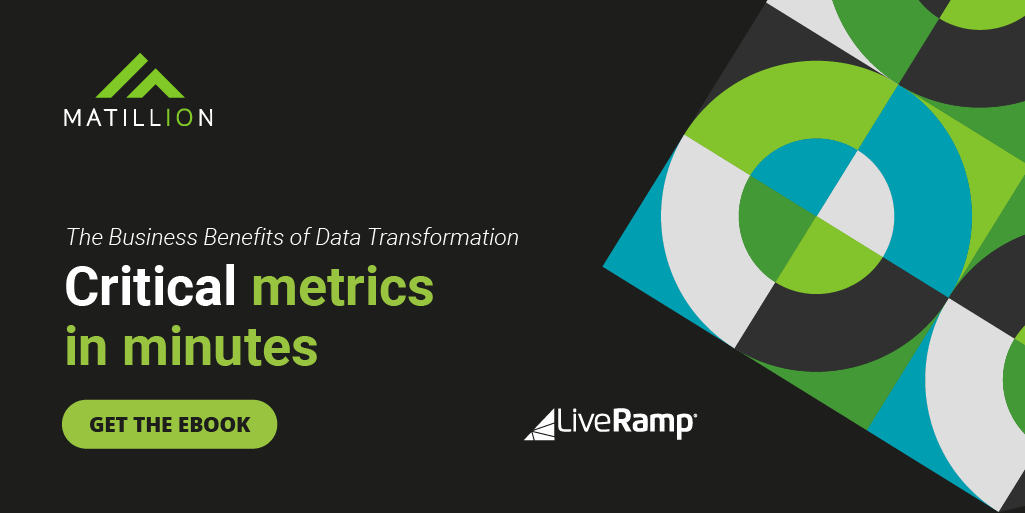- Blog
- 03.27.2020
The Importance of ETL Tools in Data Warehousing

Why Do We Need ETL Tools?
The importance of ETL in an organization is in direct proportion to how much the organization relies on data warehousing. ETL tools collect, read, and migrate large volumes of raw data from multiple data sources and across disparate platforms. They load that data into a single database, data store, or data warehouse for easy access. They process the data to make it meaningful with operations like sorting, joining, reformatting, filtering, merging, and aggregation. Finally, they include graphical interfaces for faster, easier results than traditional methods of moving data through hand-coded data pipelines.
ETL tools break down data silos and make it easy for your data scientists to access and analyze data, and turn it into business intelligence. In short, ETL tools are the first essential step in the data warehousing process that eventually lets you make more informed decisions in less time.
What Are the Different Types of ETL Tools?
Hand-coding
Companies can choose not to use any ETL tools at all. Hand-coding the processes of collecting, transforming, and migrating data is the cheapest way to begin data warehousing, since it uses existing IT resources. However, the resulting processes require maintenance for even minor changes, which drives up costs over time.
Batch processing tools
Batch processing prepares and processes data in batch files during off hours, when there’s less demand on the organization’s on-premises compute resources. Batch processing was traditionally used for workloads that aren’t urgent, such as monthly or annual reports. However, modern batch processing can be very rapid, making data available in hours, minutes, or even several seconds – just not real time.
Open source tools
Like other open source solutions, open source ETL is a collaboration among a community of software developers dedicated to flexibility, accountability, frequent updates, and the ability to integrate easily with a broad range of applications and operating systems. Ready-made and inexpensive (or even free), open source ETL is particularly appealing for organizations with limited IT resources.
Cloud-based tools
Like legacy batch processing, cloud-based batch processing preps data without affecting the performance of on-premises systems. However, you also get the advantages of platform as a service (PaaS), such as support for multiple platforms, easy integration with cloud business processes, built-in security and compliance, and managed support.
Real-time tools
Most modern open source and cloud-based ETL tools still process data in batches (though much faster and with less of a load on compute resources than traditional ETL). By comparison, real-time ETL tools capture data from and deliver data to applications in real time using distributed message queues and continuous data processing. This allows analytics tools to query Internet of Things (IoT) sensors, Twitter searches, and other streaming data, and get answers fast enough for real time marketing and other responses. However, this speed often comes at a hefty price tag, so many organizations use real-time data technology sparingly, for specialized use cases.
Which ETL tool is right for your organization?
Different ETL tools can be best suited for different needs. Tool types aren’t mutually exclusive; there are some areas of overlap, such as cloud-based tools that handle real-time data or open-source tools that are cloud-first or cloud-only. Your company’s particular requirements should guide your choice.
Batch processing. If real-time data processing isn’t a high priority, modern batch processing ETL can be both fast and cost-effective . It also makes sense for a company to retain an ETL tool and platform built specifically for its own data sources and vendors.
Open source tools. As a low-cost alternative to commercial software packages, open source ETL works well for for organizations that are comfortable operating and maintaining software themselves, want to avoid proprietary software, and don’t need to perform highly complex data transformations. But the lack of support available compared with commercially available tools can be a deal breaker for many businesses. And while some tools are open source and free for modest amounts of data, if you are working with large volumes, you may have to upgrade to a paid version.
Cloud-based tools. If your organization prefers cloud-first and cloud-native tools in general, cloud-based ETL delivers the same affordability, scalability, and ease of management while creating a migration path from on-premise and legacy applications to cloud applications and platforms. Look for a cloud-based tool that uses an ELT model, where you extract and load data into the cloud, and use the power and scale of your cloud data warehouse to transform even large amounts of data rapidly. Cloud-based tools can be hosted in the cloud as a SaaS or deployed directly into your own cloud infrastructure. Which kind of tool you use often depends on your organization’s security requirements and other factors.
Real-time tools. If you need to transform and manage big data or streaming data in real time, scale operations up or down on a dime, or give your analysts the fastest access possible to changing information, real-time ETL is for you. Keep in mind, however, that not all data needs to be processed in real time. There are still plenty of use cases in which batch processing large amounts of data is simpler and more efficient.
Benefits of data warehousing and ETL
The importance of ETL to an organization’s data warehousing efforts can’t be overstated. A modern ETL solution supports data warehousing with:
Enhanced business intelligence.
Modern ETL tools break down data silos and give self-service capabilities to the people who understand the data best, letting them draw more informed conclusions from a single source of truth in less time.
Increased query and system performance.
As expanding data volumes need to be prepared for machine learning and artificial intelligence to drive next-best-action and digital assistant technologies, companies will soon find themselves outgrowing both the capacity and the capabilities of legacy ETL systems – and with them, their data warehousing investment. As more companies look to the cloud for analytics capabilities, cloud-based ELT (extract-load-transform, rather than legacy extract-transform-load) tools will be critical in handling the large datasets required for advanced analytics, and for simply keeping pace with data growth.
Timely access to data.
Gathering and transforming data from multiple disparate systems and storing it in a single, easily accessible location alleviates bottlenecks in the data pipeline, while real-time ETL puts relevant data at users’ fingertips in fractions of a second.
Enhanced quality and consistency.
Modern ETL tools include built-in intelligence that continually detects and reflects changes in source and target objects to ensure data consistency – the lifeblood of both strategy and customer experience.
High return on investment (ROI).
Modern, cloud-based ETL tools replace expensive custom coding and manual transformations with graphical drag and drop development, scalable business rules, and faster, more accurate data processing.
Data warehousing and ETL: an unbeatable match
Without ETL tools to pull data together and render it usable, data warehousing would be difficult, if not impossible. Learn more about why data warehousing and ETL are two sides of the same coin in “What is ETL? The Ultimate Guide,” our deep dive into the critical importance of ETL in an organization.
You can also download our eBook, The Business Benefits of Cloud Data Transformation, by clicking the banner below.
Featured Resources
Building a Type 2 Slowly Changing Dimension in Matillion's Data Productivity Cloud
A Slowly Changing Dimension (SCD) is a dimension that stores and manages both current and historical data over time in a data ...
BlogEnhancing the Data Productivity Cloud via User Feedback
Find a data solution that allows you the option of low-code or high-code, extreme amounts of flexibility, tailored for cloud ...
NewsVMware and AWS Alumnus Appointed Matillion Chief Revenue Officer
Data integration firm adds cloud veteran Eric Benson to drive ...

Share: